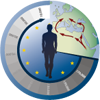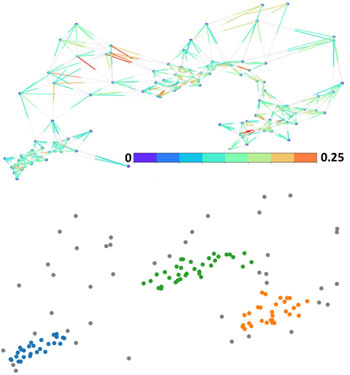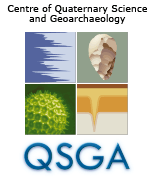Spatio-temporal clustering schemes for archaeological sites face challenges when dealing with probabilistic interpretation of uncertain dating and calibration outcomes of archaeological findings. The calibration of radiocarbon dates yields an entire probability which assigns a probability density to a continuous range of possible dates. Furthermore, algorithms need to be able to deal with various patterns across time and space.
Our probabilistic adaptation of the density-based clustering algorithm OPTICS (Ankerst et.al. 1999) can take the entire probabilistic information into account to find clusters of various shapes. We show how the distance measure of the algorithm can be interpreted in a probabilistic sense. In addition, it provides a new perspective by considering the connectivity between sites as a Markov chain by defining transition probabilities between sites.
The first figure (figure top) shows the transition probabilities from site to site, The sites have been generated artificially for this example. The colors of the line halfway from one point to another correspond to the value of the transition probability starting from the initial point and being directed halfway to the point to which the transition takes place. It is apparent that the transitions tend to be directed towards regions of higher density.
The Markov chain is in general absorbing, such that closed communication classes and transient communication classes can be identified. Regions of comparable density form communication classes. In the second figure (figure bottom), three closed communication classes have been identified. Which means, that transitions within the class can take place, but it is impossible to leave the class, once a transition into the class takes place. These classes correspond to the Gaussian clusters simulated for this example.
Cited reference:
Ankerst M, Breunig MM, Kriegel H-P, Sander J. OPTICS: ordering points to identify the clustering structure. Proceedings of the ACM International Conference on Management of Data (SIGMOD), Philadelphia, PA, 1999
Text: Heiko Limberg
Heiko Limberg is a PhD-candidate in the E6-project. He is interested in archaeological site patterns and modeling human mobility.









